Strategic Marketing Analysis and CSR: Tata Group Case Study
VerifiedAdded on 2022/08/24
|26
|6870
|13
Report
AI Summary
This report provides a comprehensive analysis of the marketing strategies employed by the Tata Group, focusing on strategic marketing planning, including Porter's generic strategies and the Ansoff matrix. It examines their approach to event planning and marketing, emphasizing stakeholder engagement and the role of strategic CSR. The report also explores the company's segment acquisition strategies, internal marketing practices, and scenario building for forecasting future implications. Through a detailed examination of these aspects, the report highlights how the Tata Group integrates various marketing techniques to achieve its business objectives and maintain a competitive edge in the market. The analysis includes an assessment of how the company fulfills stakeholder expectations and adapts its strategies to changing market dynamics.
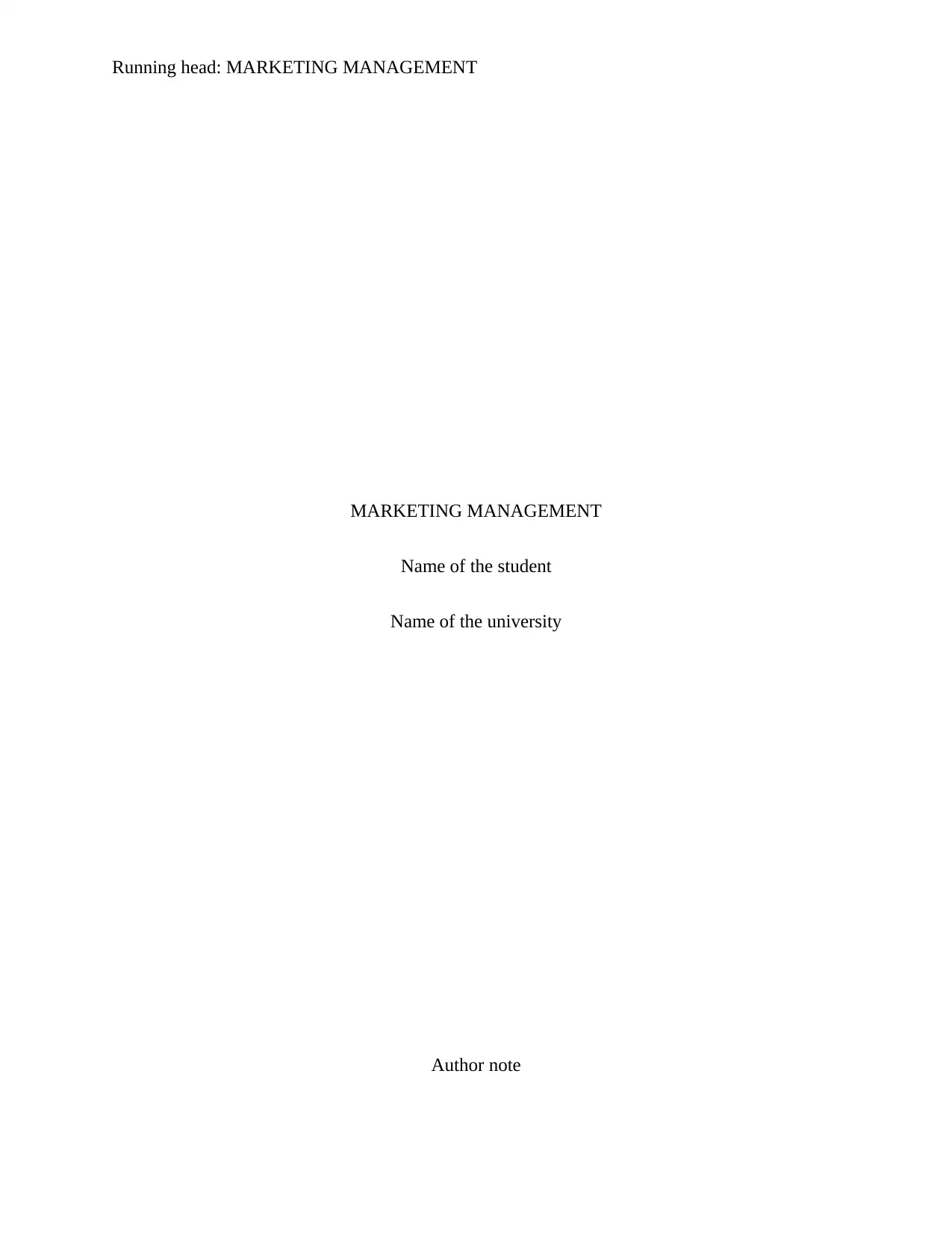
Running head: MARKETING MANAGEMENT
MARKETING MANAGEMENT
Name of the student
Name of the university
Author note
MARKETING MANAGEMENT
Name of the student
Name of the university
Author note
Paraphrase This Document
Need a fresh take? Get an instant paraphrase of this document with our AI Paraphraser
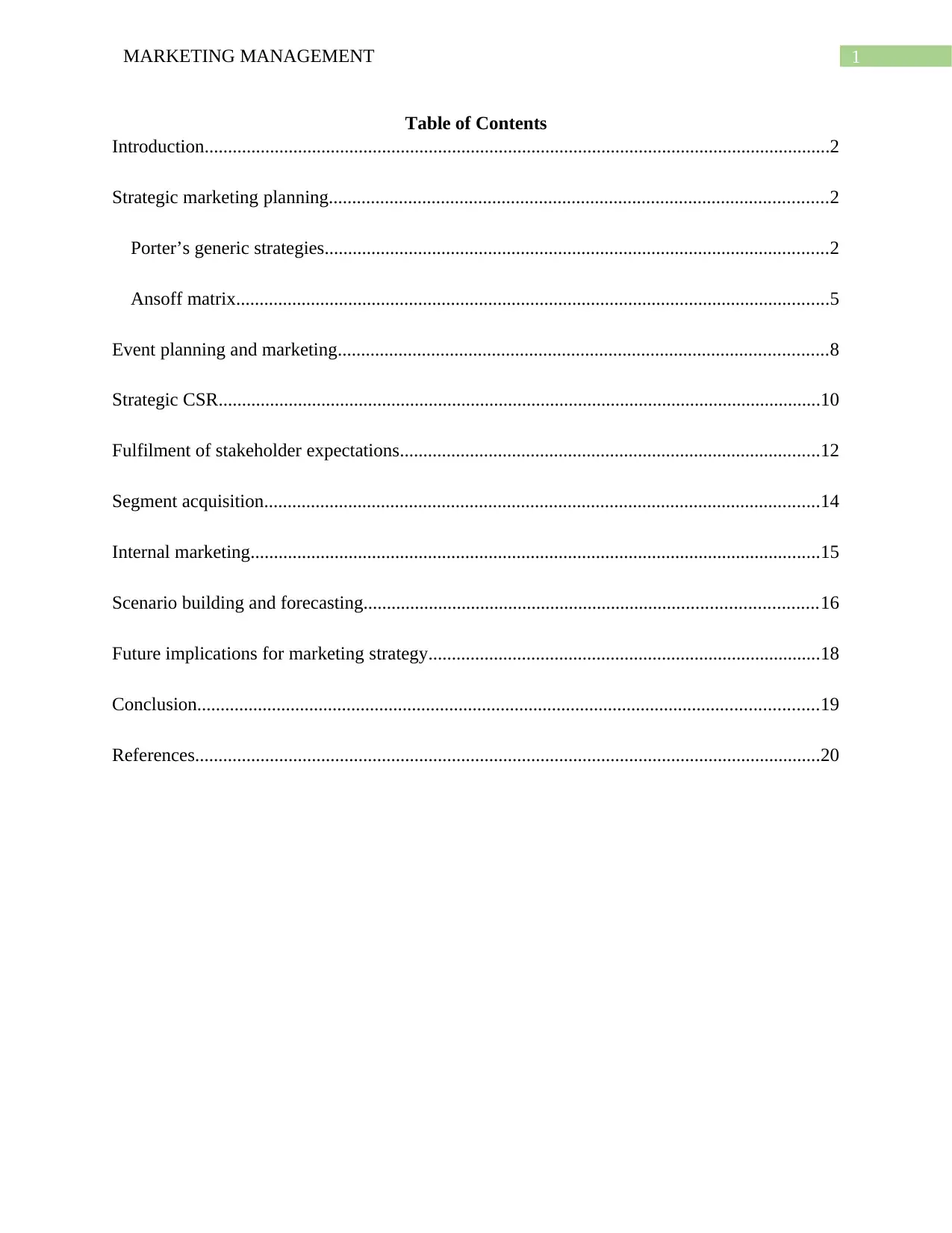
1MARKETING MANAGEMENT
Table of Contents
Introduction......................................................................................................................................2
Strategic marketing planning...........................................................................................................2
Porter’s generic strategies............................................................................................................2
Ansoff matrix...............................................................................................................................5
Event planning and marketing.........................................................................................................8
Strategic CSR.................................................................................................................................10
Fulfilment of stakeholder expectations..........................................................................................12
Segment acquisition.......................................................................................................................14
Internal marketing..........................................................................................................................15
Scenario building and forecasting.................................................................................................16
Future implications for marketing strategy....................................................................................18
Conclusion.....................................................................................................................................19
References......................................................................................................................................20
Table of Contents
Introduction......................................................................................................................................2
Strategic marketing planning...........................................................................................................2
Porter’s generic strategies............................................................................................................2
Ansoff matrix...............................................................................................................................5
Event planning and marketing.........................................................................................................8
Strategic CSR.................................................................................................................................10
Fulfilment of stakeholder expectations..........................................................................................12
Segment acquisition.......................................................................................................................14
Internal marketing..........................................................................................................................15
Scenario building and forecasting.................................................................................................16
Future implications for marketing strategy....................................................................................18
Conclusion.....................................................................................................................................19
References......................................................................................................................................20
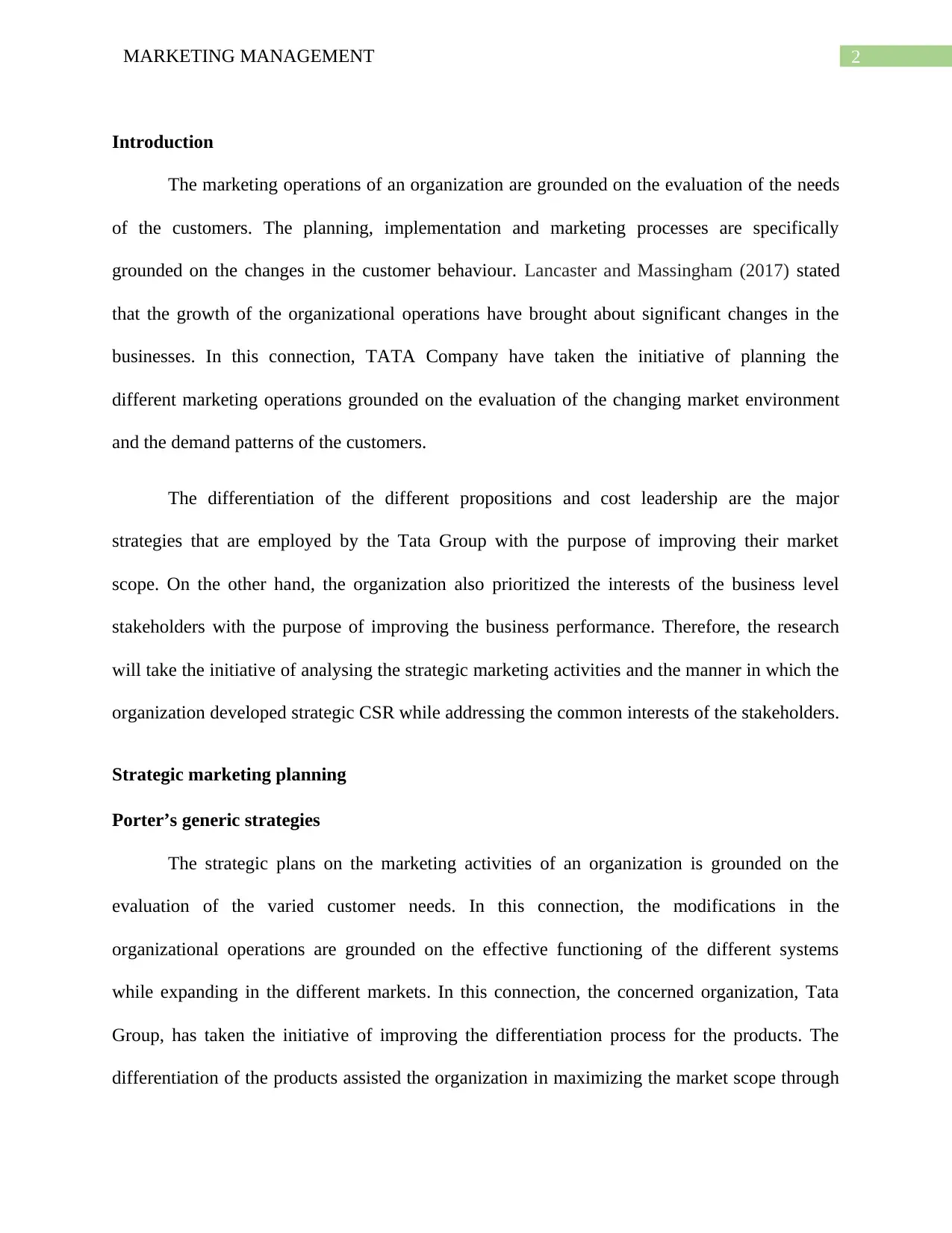
2MARKETING MANAGEMENT
Introduction
The marketing operations of an organization are grounded on the evaluation of the needs
of the customers. The planning, implementation and marketing processes are specifically
grounded on the changes in the customer behaviour. Lancaster and Massingham (2017) stated
that the growth of the organizational operations have brought about significant changes in the
businesses. In this connection, TATA Company have taken the initiative of planning the
different marketing operations grounded on the evaluation of the changing market environment
and the demand patterns of the customers.
The differentiation of the different propositions and cost leadership are the major
strategies that are employed by the Tata Group with the purpose of improving their market
scope. On the other hand, the organization also prioritized the interests of the business level
stakeholders with the purpose of improving the business performance. Therefore, the research
will take the initiative of analysing the strategic marketing activities and the manner in which the
organization developed strategic CSR while addressing the common interests of the stakeholders.
Strategic marketing planning
Porter’s generic strategies
The strategic plans on the marketing activities of an organization is grounded on the
evaluation of the varied customer needs. In this connection, the modifications in the
organizational operations are grounded on the effective functioning of the different systems
while expanding in the different markets. In this connection, the concerned organization, Tata
Group, has taken the initiative of improving the differentiation process for the products. The
differentiation of the products assisted the organization in maximizing the market scope through
Introduction
The marketing operations of an organization are grounded on the evaluation of the needs
of the customers. The planning, implementation and marketing processes are specifically
grounded on the changes in the customer behaviour. Lancaster and Massingham (2017) stated
that the growth of the organizational operations have brought about significant changes in the
businesses. In this connection, TATA Company have taken the initiative of planning the
different marketing operations grounded on the evaluation of the changing market environment
and the demand patterns of the customers.
The differentiation of the different propositions and cost leadership are the major
strategies that are employed by the Tata Group with the purpose of improving their market
scope. On the other hand, the organization also prioritized the interests of the business level
stakeholders with the purpose of improving the business performance. Therefore, the research
will take the initiative of analysing the strategic marketing activities and the manner in which the
organization developed strategic CSR while addressing the common interests of the stakeholders.
Strategic marketing planning
Porter’s generic strategies
The strategic plans on the marketing activities of an organization is grounded on the
evaluation of the varied customer needs. In this connection, the modifications in the
organizational operations are grounded on the effective functioning of the different systems
while expanding in the different markets. In this connection, the concerned organization, Tata
Group, has taken the initiative of improving the differentiation process for the products. The
differentiation of the products assisted the organization in maximizing the market scope through
⊘ This is a preview!⊘
Do you want full access?
Subscribe today to unlock all pages.

Trusted by 1+ million students worldwide
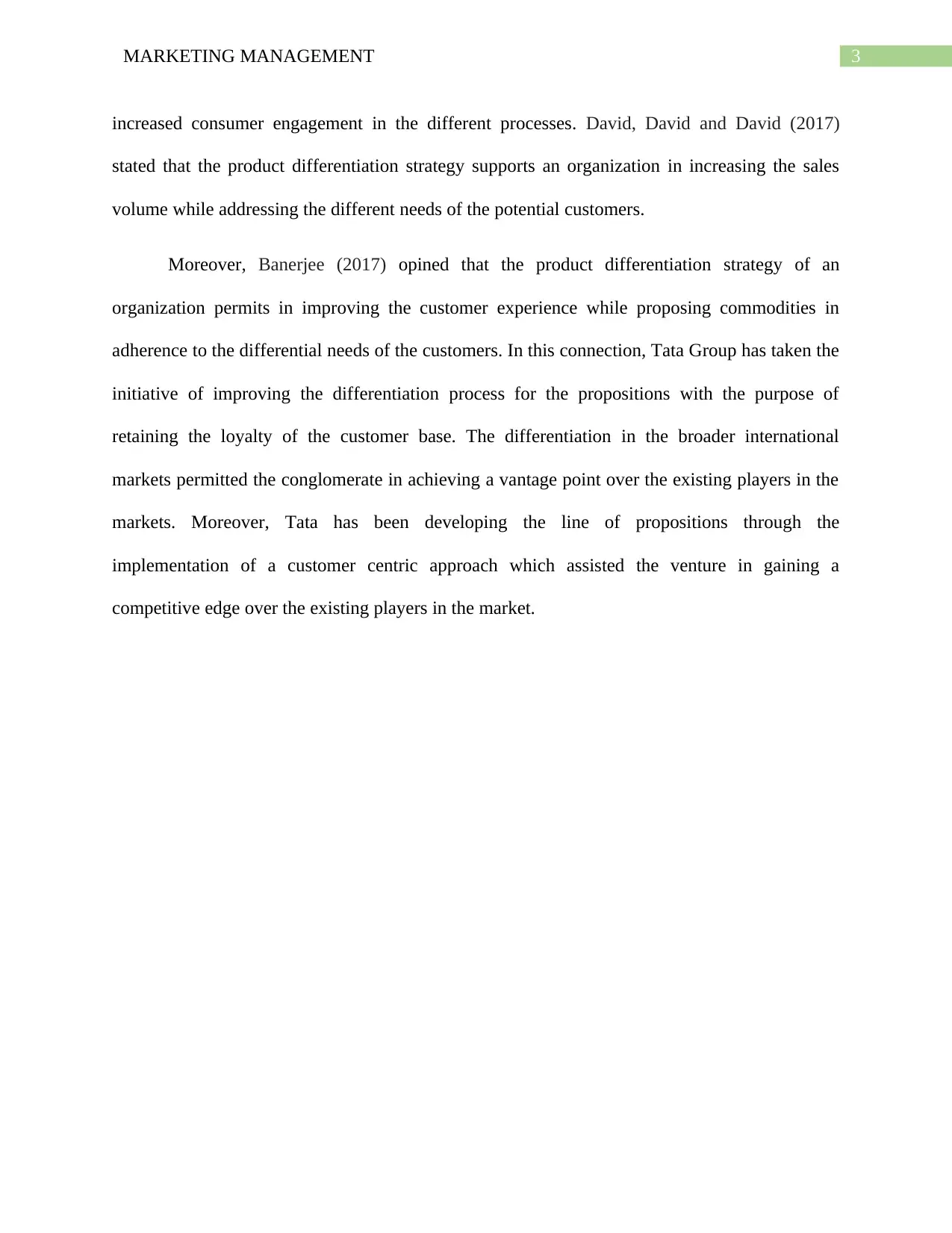
3MARKETING MANAGEMENT
increased consumer engagement in the different processes. David, David and David (2017)
stated that the product differentiation strategy supports an organization in increasing the sales
volume while addressing the different needs of the potential customers.
Moreover, Banerjee (2017) opined that the product differentiation strategy of an
organization permits in improving the customer experience while proposing commodities in
adherence to the differential needs of the customers. In this connection, Tata Group has taken the
initiative of improving the differentiation process for the propositions with the purpose of
retaining the loyalty of the customer base. The differentiation in the broader international
markets permitted the conglomerate in achieving a vantage point over the existing players in the
markets. Moreover, Tata has been developing the line of propositions through the
implementation of a customer centric approach which assisted the venture in gaining a
competitive edge over the existing players in the market.
increased consumer engagement in the different processes. David, David and David (2017)
stated that the product differentiation strategy supports an organization in increasing the sales
volume while addressing the different needs of the potential customers.
Moreover, Banerjee (2017) opined that the product differentiation strategy of an
organization permits in improving the customer experience while proposing commodities in
adherence to the differential needs of the customers. In this connection, Tata Group has taken the
initiative of improving the differentiation process for the propositions with the purpose of
retaining the loyalty of the customer base. The differentiation in the broader international
markets permitted the conglomerate in achieving a vantage point over the existing players in the
markets. Moreover, Tata has been developing the line of propositions through the
implementation of a customer centric approach which assisted the venture in gaining a
competitive edge over the existing players in the market.
Paraphrase This Document
Need a fresh take? Get an instant paraphrase of this document with our AI Paraphraser
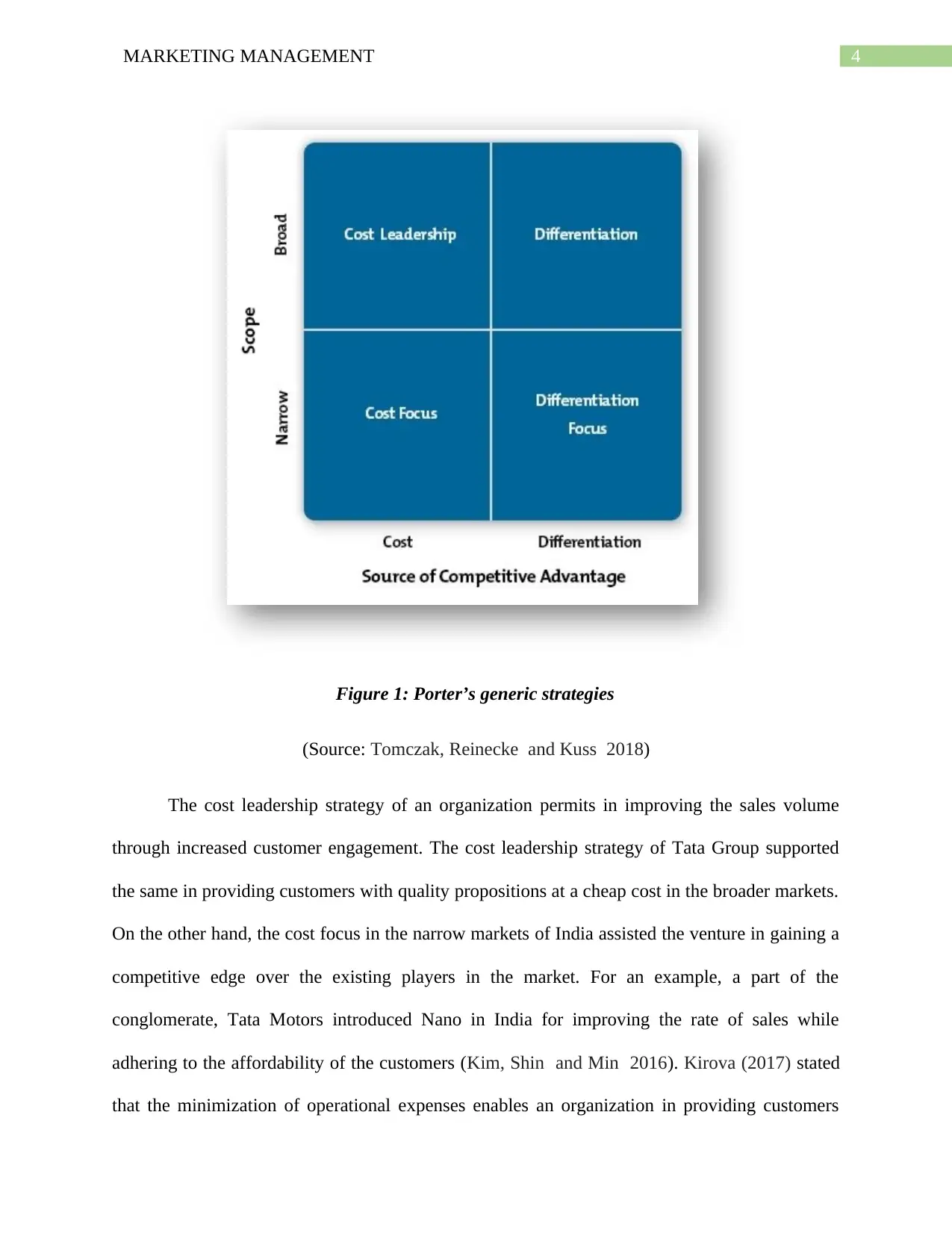
4MARKETING MANAGEMENT
Figure 1: Porter’s generic strategies
(Source: Tomczak, Reinecke and Kuss 2018)
The cost leadership strategy of an organization permits in improving the sales volume
through increased customer engagement. The cost leadership strategy of Tata Group supported
the same in providing customers with quality propositions at a cheap cost in the broader markets.
On the other hand, the cost focus in the narrow markets of India assisted the venture in gaining a
competitive edge over the existing players in the market. For an example, a part of the
conglomerate, Tata Motors introduced Nano in India for improving the rate of sales while
adhering to the affordability of the customers (Kim, Shin and Min 2016). Kirova (2017) stated
that the minimization of operational expenses enables an organization in providing customers
Figure 1: Porter’s generic strategies
(Source: Tomczak, Reinecke and Kuss 2018)
The cost leadership strategy of an organization permits in improving the sales volume
through increased customer engagement. The cost leadership strategy of Tata Group supported
the same in providing customers with quality propositions at a cheap cost in the broader markets.
On the other hand, the cost focus in the narrow markets of India assisted the venture in gaining a
competitive edge over the existing players in the market. For an example, a part of the
conglomerate, Tata Motors introduced Nano in India for improving the rate of sales while
adhering to the affordability of the customers (Kim, Shin and Min 2016). Kirova (2017) stated
that the minimization of operational expenses enables an organization in providing customers
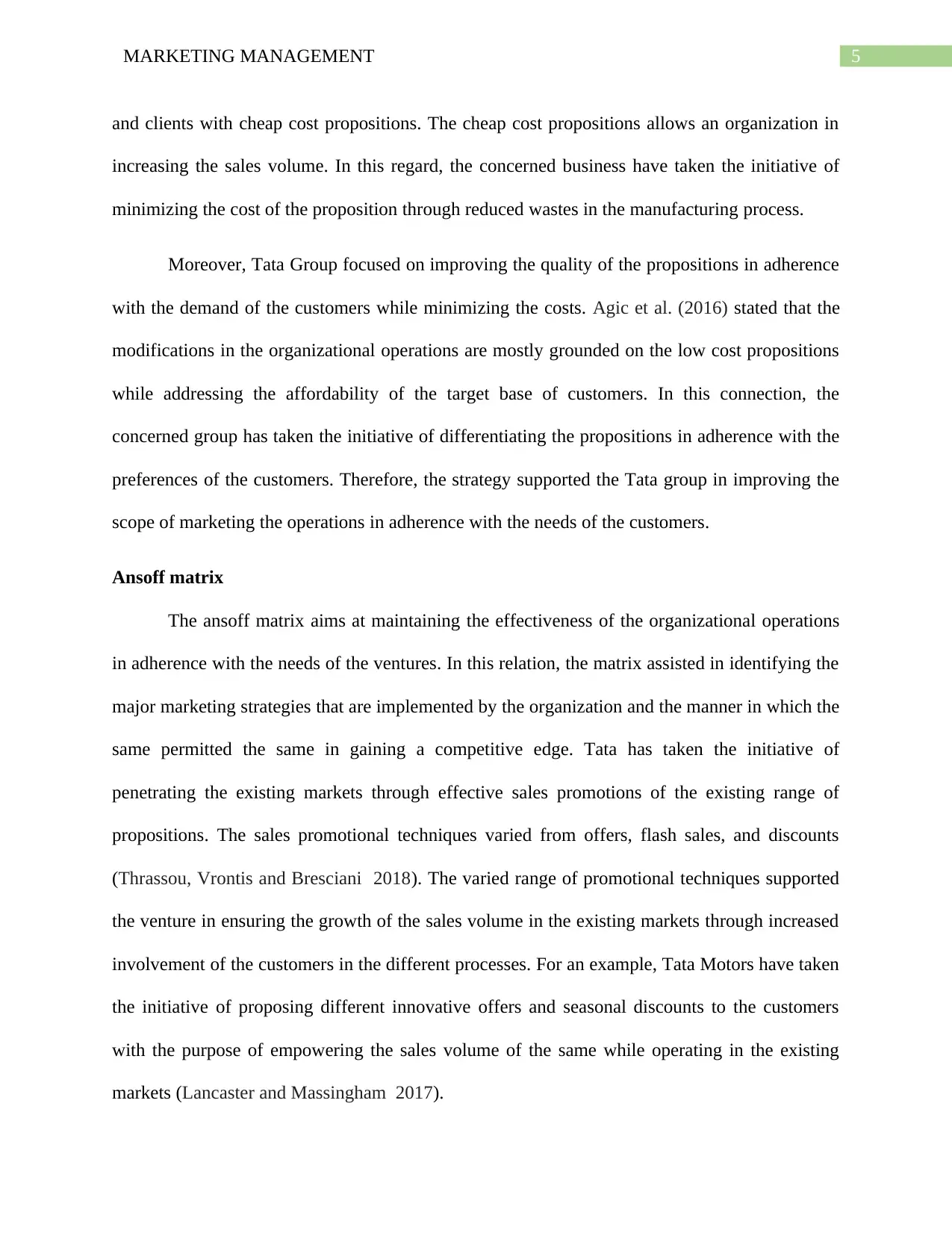
5MARKETING MANAGEMENT
and clients with cheap cost propositions. The cheap cost propositions allows an organization in
increasing the sales volume. In this regard, the concerned business have taken the initiative of
minimizing the cost of the proposition through reduced wastes in the manufacturing process.
Moreover, Tata Group focused on improving the quality of the propositions in adherence
with the demand of the customers while minimizing the costs. Agic et al. (2016) stated that the
modifications in the organizational operations are mostly grounded on the low cost propositions
while addressing the affordability of the target base of customers. In this connection, the
concerned group has taken the initiative of differentiating the propositions in adherence with the
preferences of the customers. Therefore, the strategy supported the Tata group in improving the
scope of marketing the operations in adherence with the needs of the customers.
Ansoff matrix
The ansoff matrix aims at maintaining the effectiveness of the organizational operations
in adherence with the needs of the ventures. In this relation, the matrix assisted in identifying the
major marketing strategies that are implemented by the organization and the manner in which the
same permitted the same in gaining a competitive edge. Tata has taken the initiative of
penetrating the existing markets through effective sales promotions of the existing range of
propositions. The sales promotional techniques varied from offers, flash sales, and discounts
(Thrassou, Vrontis and Bresciani 2018). The varied range of promotional techniques supported
the venture in ensuring the growth of the sales volume in the existing markets through increased
involvement of the customers in the different processes. For an example, Tata Motors have taken
the initiative of proposing different innovative offers and seasonal discounts to the customers
with the purpose of empowering the sales volume of the same while operating in the existing
markets (Lancaster and Massingham 2017).
and clients with cheap cost propositions. The cheap cost propositions allows an organization in
increasing the sales volume. In this regard, the concerned business have taken the initiative of
minimizing the cost of the proposition through reduced wastes in the manufacturing process.
Moreover, Tata Group focused on improving the quality of the propositions in adherence
with the demand of the customers while minimizing the costs. Agic et al. (2016) stated that the
modifications in the organizational operations are mostly grounded on the low cost propositions
while addressing the affordability of the target base of customers. In this connection, the
concerned group has taken the initiative of differentiating the propositions in adherence with the
preferences of the customers. Therefore, the strategy supported the Tata group in improving the
scope of marketing the operations in adherence with the needs of the customers.
Ansoff matrix
The ansoff matrix aims at maintaining the effectiveness of the organizational operations
in adherence with the needs of the ventures. In this relation, the matrix assisted in identifying the
major marketing strategies that are implemented by the organization and the manner in which the
same permitted the same in gaining a competitive edge. Tata has taken the initiative of
penetrating the existing markets through effective sales promotions of the existing range of
propositions. The sales promotional techniques varied from offers, flash sales, and discounts
(Thrassou, Vrontis and Bresciani 2018). The varied range of promotional techniques supported
the venture in ensuring the growth of the sales volume in the existing markets through increased
involvement of the customers in the different processes. For an example, Tata Motors have taken
the initiative of proposing different innovative offers and seasonal discounts to the customers
with the purpose of empowering the sales volume of the same while operating in the existing
markets (Lancaster and Massingham 2017).
⊘ This is a preview!⊘
Do you want full access?
Subscribe today to unlock all pages.

Trusted by 1+ million students worldwide
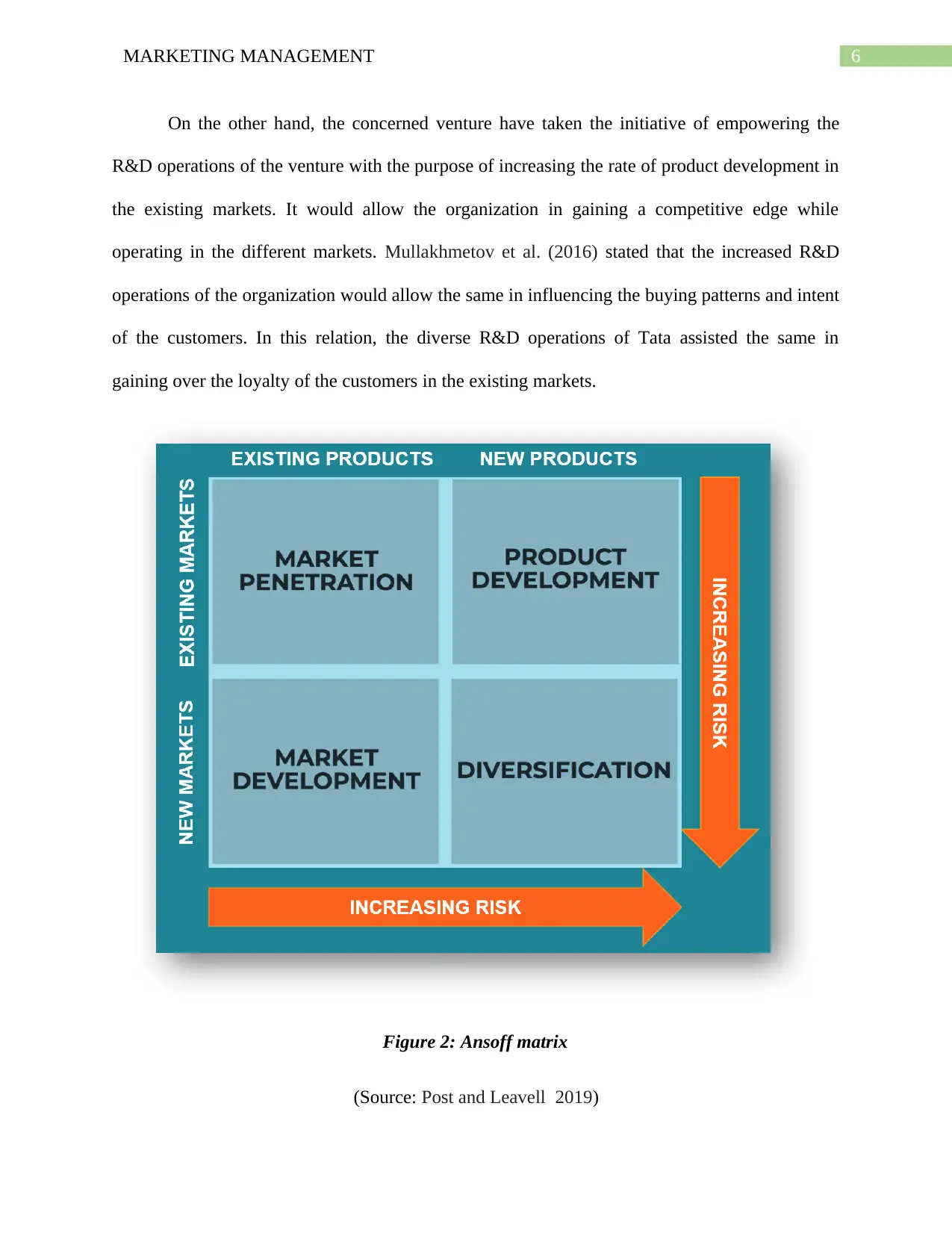
6MARKETING MANAGEMENT
On the other hand, the concerned venture have taken the initiative of empowering the
R&D operations of the venture with the purpose of increasing the rate of product development in
the existing markets. It would allow the organization in gaining a competitive edge while
operating in the different markets. Mullakhmetov et al. (2016) stated that the increased R&D
operations of the organization would allow the same in influencing the buying patterns and intent
of the customers. In this relation, the diverse R&D operations of Tata assisted the same in
gaining over the loyalty of the customers in the existing markets.
Figure 2: Ansoff matrix
(Source: Post and Leavell 2019)
On the other hand, the concerned venture have taken the initiative of empowering the
R&D operations of the venture with the purpose of increasing the rate of product development in
the existing markets. It would allow the organization in gaining a competitive edge while
operating in the different markets. Mullakhmetov et al. (2016) stated that the increased R&D
operations of the organization would allow the same in influencing the buying patterns and intent
of the customers. In this relation, the diverse R&D operations of Tata assisted the same in
gaining over the loyalty of the customers in the existing markets.
Figure 2: Ansoff matrix
(Source: Post and Leavell 2019)
Paraphrase This Document
Need a fresh take? Get an instant paraphrase of this document with our AI Paraphraser
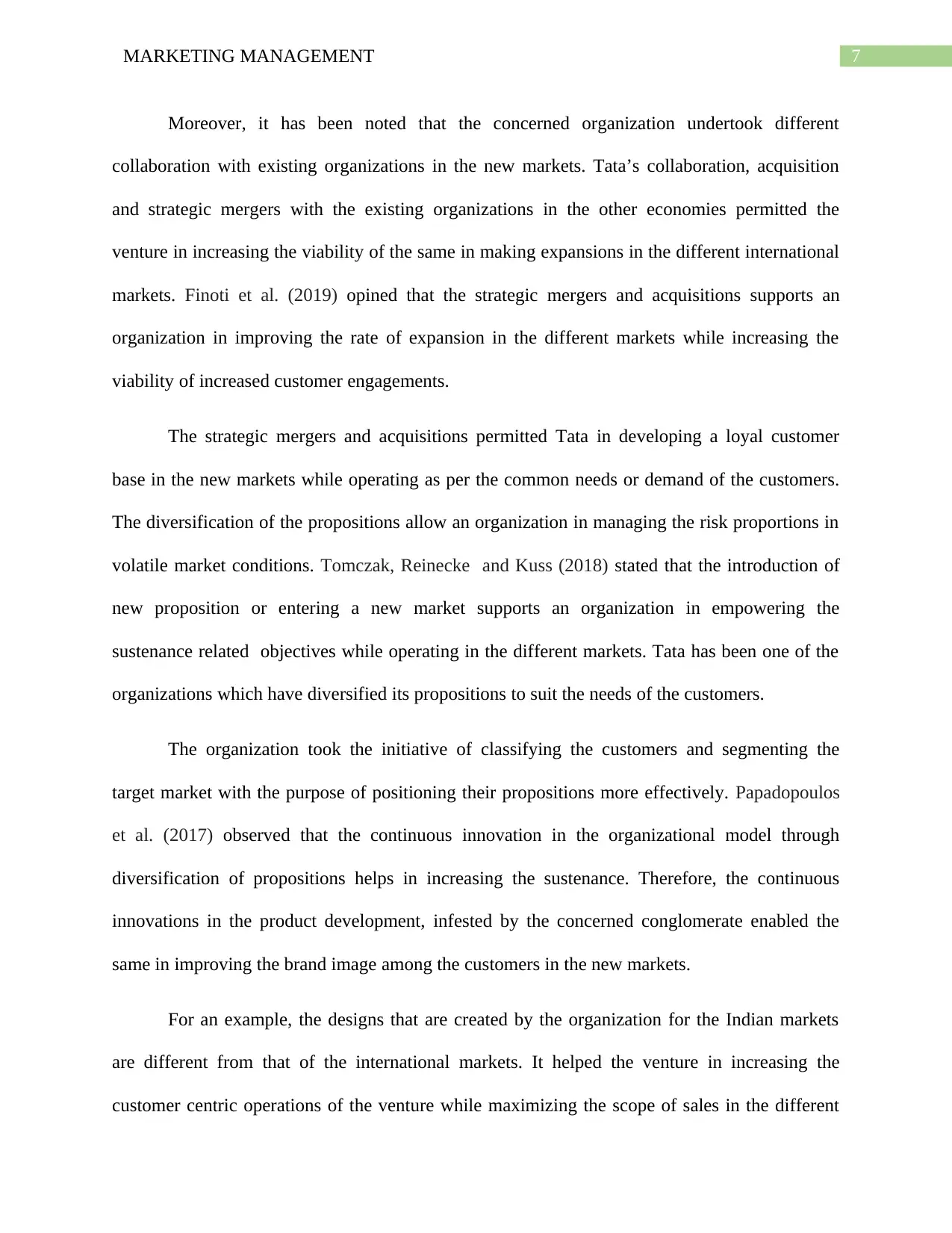
7MARKETING MANAGEMENT
Moreover, it has been noted that the concerned organization undertook different
collaboration with existing organizations in the new markets. Tata’s collaboration, acquisition
and strategic mergers with the existing organizations in the other economies permitted the
venture in increasing the viability of the same in making expansions in the different international
markets. Finoti et al. (2019) opined that the strategic mergers and acquisitions supports an
organization in improving the rate of expansion in the different markets while increasing the
viability of increased customer engagements.
The strategic mergers and acquisitions permitted Tata in developing a loyal customer
base in the new markets while operating as per the common needs or demand of the customers.
The diversification of the propositions allow an organization in managing the risk proportions in
volatile market conditions. Tomczak, Reinecke and Kuss (2018) stated that the introduction of
new proposition or entering a new market supports an organization in empowering the
sustenance related objectives while operating in the different markets. Tata has been one of the
organizations which have diversified its propositions to suit the needs of the customers.
The organization took the initiative of classifying the customers and segmenting the
target market with the purpose of positioning their propositions more effectively. Papadopoulos
et al. (2017) observed that the continuous innovation in the organizational model through
diversification of propositions helps in increasing the sustenance. Therefore, the continuous
innovations in the product development, infested by the concerned conglomerate enabled the
same in improving the brand image among the customers in the new markets.
For an example, the designs that are created by the organization for the Indian markets
are different from that of the international markets. It helped the venture in increasing the
customer centric operations of the venture while maximizing the scope of sales in the different
Moreover, it has been noted that the concerned organization undertook different
collaboration with existing organizations in the new markets. Tata’s collaboration, acquisition
and strategic mergers with the existing organizations in the other economies permitted the
venture in increasing the viability of the same in making expansions in the different international
markets. Finoti et al. (2019) opined that the strategic mergers and acquisitions supports an
organization in improving the rate of expansion in the different markets while increasing the
viability of increased customer engagements.
The strategic mergers and acquisitions permitted Tata in developing a loyal customer
base in the new markets while operating as per the common needs or demand of the customers.
The diversification of the propositions allow an organization in managing the risk proportions in
volatile market conditions. Tomczak, Reinecke and Kuss (2018) stated that the introduction of
new proposition or entering a new market supports an organization in empowering the
sustenance related objectives while operating in the different markets. Tata has been one of the
organizations which have diversified its propositions to suit the needs of the customers.
The organization took the initiative of classifying the customers and segmenting the
target market with the purpose of positioning their propositions more effectively. Papadopoulos
et al. (2017) observed that the continuous innovation in the organizational model through
diversification of propositions helps in increasing the sustenance. Therefore, the continuous
innovations in the product development, infested by the concerned conglomerate enabled the
same in improving the brand image among the customers in the new markets.
For an example, the designs that are created by the organization for the Indian markets
are different from that of the international markets. It helped the venture in increasing the
customer centric operations of the venture while maximizing the scope of sales in the different
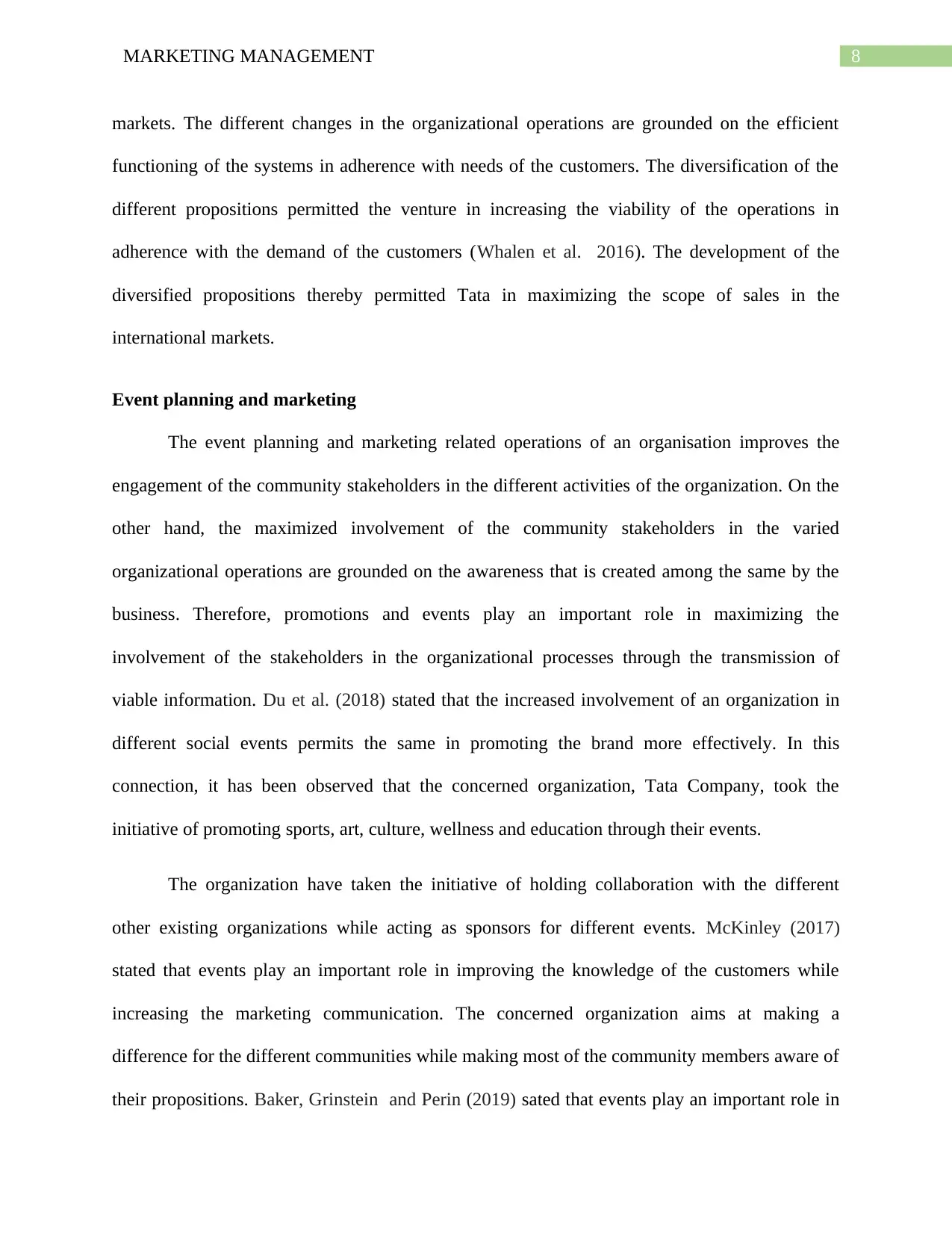
8MARKETING MANAGEMENT
markets. The different changes in the organizational operations are grounded on the efficient
functioning of the systems in adherence with needs of the customers. The diversification of the
different propositions permitted the venture in increasing the viability of the operations in
adherence with the demand of the customers (Whalen et al. 2016). The development of the
diversified propositions thereby permitted Tata in maximizing the scope of sales in the
international markets.
Event planning and marketing
The event planning and marketing related operations of an organisation improves the
engagement of the community stakeholders in the different activities of the organization. On the
other hand, the maximized involvement of the community stakeholders in the varied
organizational operations are grounded on the awareness that is created among the same by the
business. Therefore, promotions and events play an important role in maximizing the
involvement of the stakeholders in the organizational processes through the transmission of
viable information. Du et al. (2018) stated that the increased involvement of an organization in
different social events permits the same in promoting the brand more effectively. In this
connection, it has been observed that the concerned organization, Tata Company, took the
initiative of promoting sports, art, culture, wellness and education through their events.
The organization have taken the initiative of holding collaboration with the different
other existing organizations while acting as sponsors for different events. McKinley (2017)
stated that events play an important role in improving the knowledge of the customers while
increasing the marketing communication. The concerned organization aims at making a
difference for the different communities while making most of the community members aware of
their propositions. Baker, Grinstein and Perin (2019) sated that events play an important role in
markets. The different changes in the organizational operations are grounded on the efficient
functioning of the systems in adherence with needs of the customers. The diversification of the
different propositions permitted the venture in increasing the viability of the operations in
adherence with the demand of the customers (Whalen et al. 2016). The development of the
diversified propositions thereby permitted Tata in maximizing the scope of sales in the
international markets.
Event planning and marketing
The event planning and marketing related operations of an organisation improves the
engagement of the community stakeholders in the different activities of the organization. On the
other hand, the maximized involvement of the community stakeholders in the varied
organizational operations are grounded on the awareness that is created among the same by the
business. Therefore, promotions and events play an important role in maximizing the
involvement of the stakeholders in the organizational processes through the transmission of
viable information. Du et al. (2018) stated that the increased involvement of an organization in
different social events permits the same in promoting the brand more effectively. In this
connection, it has been observed that the concerned organization, Tata Company, took the
initiative of promoting sports, art, culture, wellness and education through their events.
The organization have taken the initiative of holding collaboration with the different
other existing organizations while acting as sponsors for different events. McKinley (2017)
stated that events play an important role in improving the knowledge of the customers while
increasing the marketing communication. The concerned organization aims at making a
difference for the different communities while making most of the community members aware of
their propositions. Baker, Grinstein and Perin (2019) sated that events play an important role in
⊘ This is a preview!⊘
Do you want full access?
Subscribe today to unlock all pages.

Trusted by 1+ million students worldwide
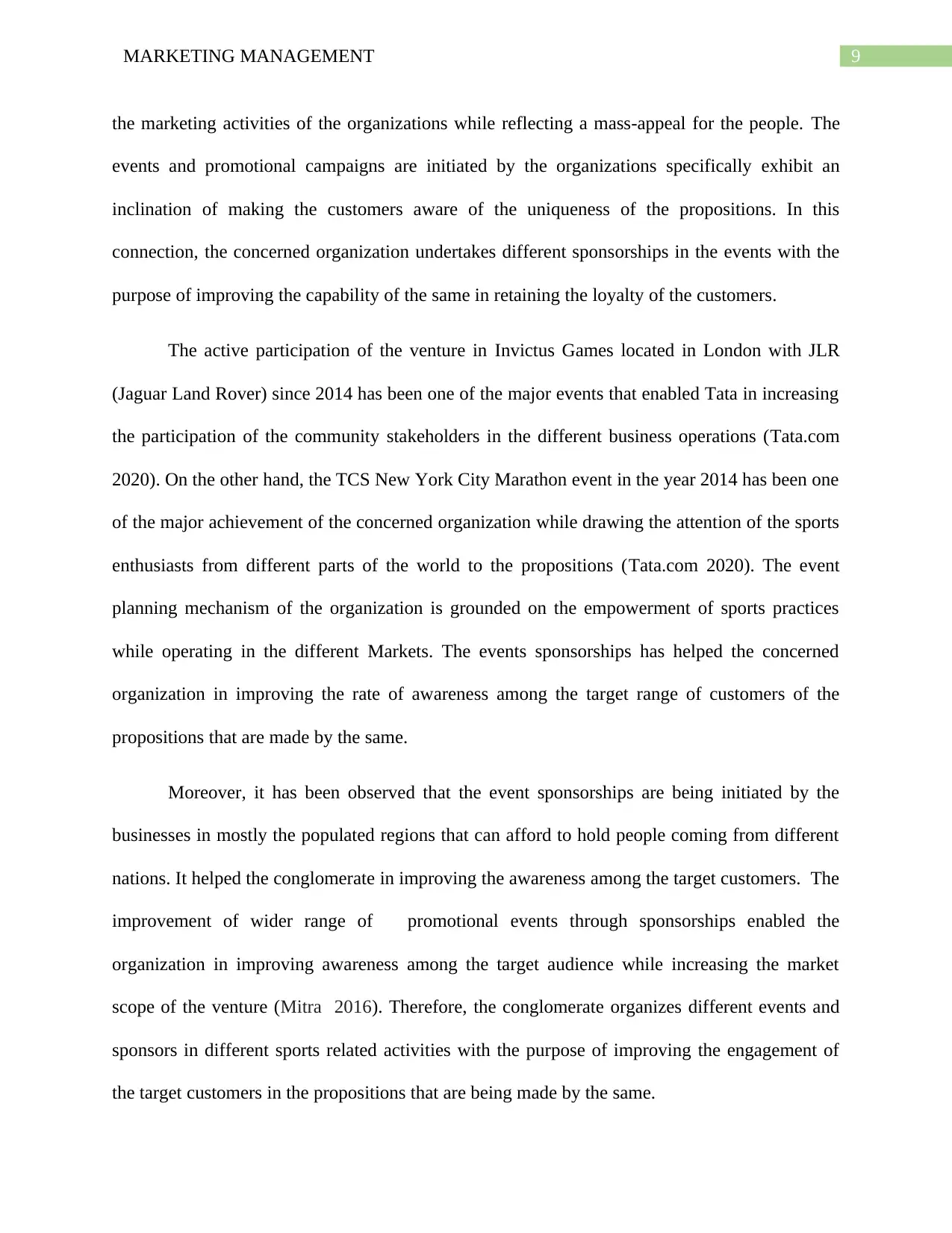
9MARKETING MANAGEMENT
the marketing activities of the organizations while reflecting a mass-appeal for the people. The
events and promotional campaigns are initiated by the organizations specifically exhibit an
inclination of making the customers aware of the uniqueness of the propositions. In this
connection, the concerned organization undertakes different sponsorships in the events with the
purpose of improving the capability of the same in retaining the loyalty of the customers.
The active participation of the venture in Invictus Games located in London with JLR
(Jaguar Land Rover) since 2014 has been one of the major events that enabled Tata in increasing
the participation of the community stakeholders in the different business operations (Tata.com
2020). On the other hand, the TCS New York City Marathon event in the year 2014 has been one
of the major achievement of the concerned organization while drawing the attention of the sports
enthusiasts from different parts of the world to the propositions (Tata.com 2020). The event
planning mechanism of the organization is grounded on the empowerment of sports practices
while operating in the different Markets. The events sponsorships has helped the concerned
organization in improving the rate of awareness among the target range of customers of the
propositions that are made by the same.
Moreover, it has been observed that the event sponsorships are being initiated by the
businesses in mostly the populated regions that can afford to hold people coming from different
nations. It helped the conglomerate in improving the awareness among the target customers. The
improvement of wider range of promotional events through sponsorships enabled the
organization in improving awareness among the target audience while increasing the market
scope of the venture (Mitra 2016). Therefore, the conglomerate organizes different events and
sponsors in different sports related activities with the purpose of improving the engagement of
the target customers in the propositions that are being made by the same.
the marketing activities of the organizations while reflecting a mass-appeal for the people. The
events and promotional campaigns are initiated by the organizations specifically exhibit an
inclination of making the customers aware of the uniqueness of the propositions. In this
connection, the concerned organization undertakes different sponsorships in the events with the
purpose of improving the capability of the same in retaining the loyalty of the customers.
The active participation of the venture in Invictus Games located in London with JLR
(Jaguar Land Rover) since 2014 has been one of the major events that enabled Tata in increasing
the participation of the community stakeholders in the different business operations (Tata.com
2020). On the other hand, the TCS New York City Marathon event in the year 2014 has been one
of the major achievement of the concerned organization while drawing the attention of the sports
enthusiasts from different parts of the world to the propositions (Tata.com 2020). The event
planning mechanism of the organization is grounded on the empowerment of sports practices
while operating in the different Markets. The events sponsorships has helped the concerned
organization in improving the rate of awareness among the target range of customers of the
propositions that are made by the same.
Moreover, it has been observed that the event sponsorships are being initiated by the
businesses in mostly the populated regions that can afford to hold people coming from different
nations. It helped the conglomerate in improving the awareness among the target customers. The
improvement of wider range of promotional events through sponsorships enabled the
organization in improving awareness among the target audience while increasing the market
scope of the venture (Mitra 2016). Therefore, the conglomerate organizes different events and
sponsors in different sports related activities with the purpose of improving the engagement of
the target customers in the propositions that are being made by the same.
Paraphrase This Document
Need a fresh take? Get an instant paraphrase of this document with our AI Paraphraser
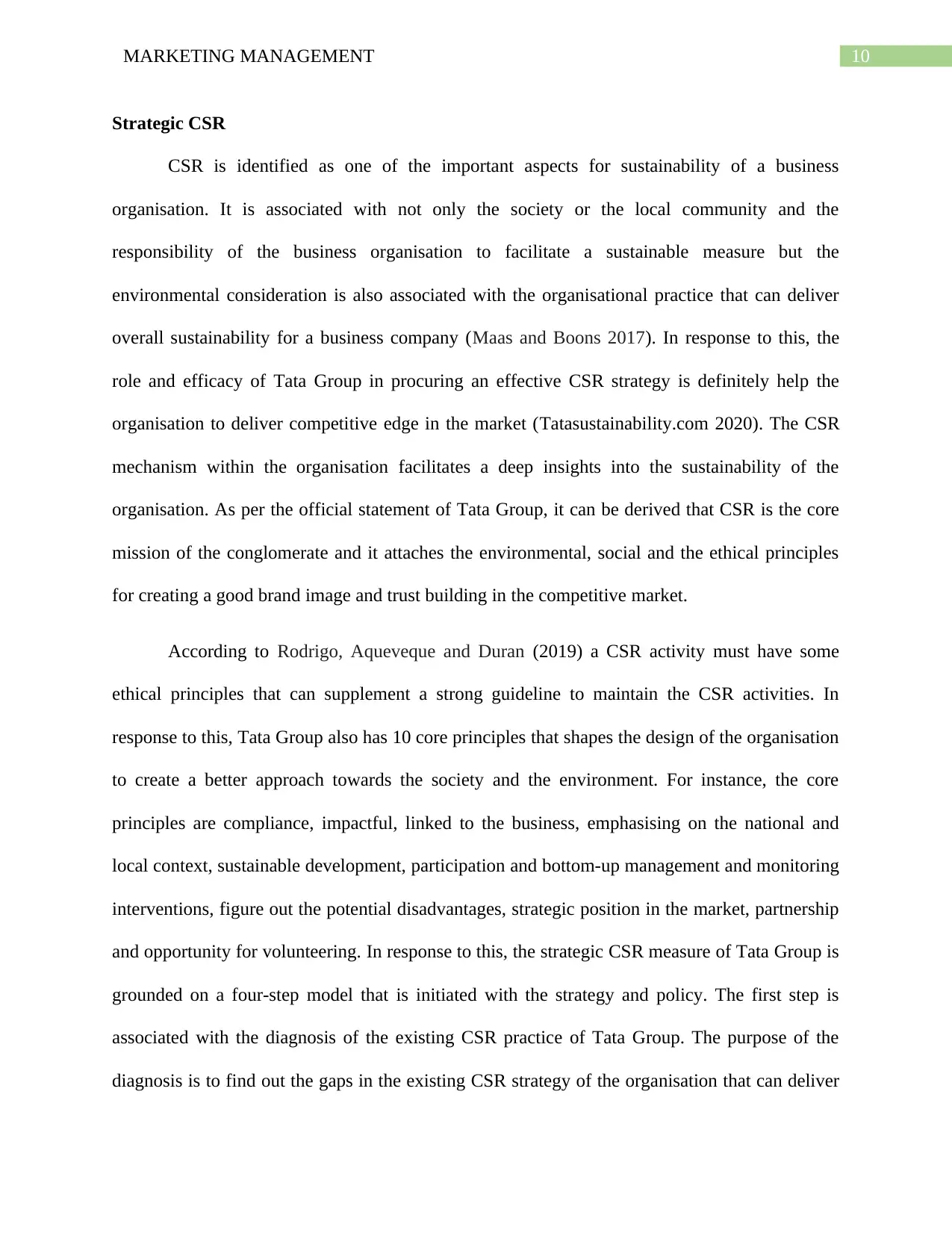
10MARKETING MANAGEMENT
Strategic CSR
CSR is identified as one of the important aspects for sustainability of a business
organisation. It is associated with not only the society or the local community and the
responsibility of the business organisation to facilitate a sustainable measure but the
environmental consideration is also associated with the organisational practice that can deliver
overall sustainability for a business company (Maas and Boons 2017). In response to this, the
role and efficacy of Tata Group in procuring an effective CSR strategy is definitely help the
organisation to deliver competitive edge in the market (Tatasustainability.com 2020). The CSR
mechanism within the organisation facilitates a deep insights into the sustainability of the
organisation. As per the official statement of Tata Group, it can be derived that CSR is the core
mission of the conglomerate and it attaches the environmental, social and the ethical principles
for creating a good brand image and trust building in the competitive market.
According to Rodrigo, Aqueveque and Duran (2019) a CSR activity must have some
ethical principles that can supplement a strong guideline to maintain the CSR activities. In
response to this, Tata Group also has 10 core principles that shapes the design of the organisation
to create a better approach towards the society and the environment. For instance, the core
principles are compliance, impactful, linked to the business, emphasising on the national and
local context, sustainable development, participation and bottom-up management and monitoring
interventions, figure out the potential disadvantages, strategic position in the market, partnership
and opportunity for volunteering. In response to this, the strategic CSR measure of Tata Group is
grounded on a four-step model that is initiated with the strategy and policy. The first step is
associated with the diagnosis of the existing CSR practice of Tata Group. The purpose of the
diagnosis is to find out the gaps in the existing CSR strategy of the organisation that can deliver
Strategic CSR
CSR is identified as one of the important aspects for sustainability of a business
organisation. It is associated with not only the society or the local community and the
responsibility of the business organisation to facilitate a sustainable measure but the
environmental consideration is also associated with the organisational practice that can deliver
overall sustainability for a business company (Maas and Boons 2017). In response to this, the
role and efficacy of Tata Group in procuring an effective CSR strategy is definitely help the
organisation to deliver competitive edge in the market (Tatasustainability.com 2020). The CSR
mechanism within the organisation facilitates a deep insights into the sustainability of the
organisation. As per the official statement of Tata Group, it can be derived that CSR is the core
mission of the conglomerate and it attaches the environmental, social and the ethical principles
for creating a good brand image and trust building in the competitive market.
According to Rodrigo, Aqueveque and Duran (2019) a CSR activity must have some
ethical principles that can supplement a strong guideline to maintain the CSR activities. In
response to this, Tata Group also has 10 core principles that shapes the design of the organisation
to create a better approach towards the society and the environment. For instance, the core
principles are compliance, impactful, linked to the business, emphasising on the national and
local context, sustainable development, participation and bottom-up management and monitoring
interventions, figure out the potential disadvantages, strategic position in the market, partnership
and opportunity for volunteering. In response to this, the strategic CSR measure of Tata Group is
grounded on a four-step model that is initiated with the strategy and policy. The first step is
associated with the diagnosis of the existing CSR practice of Tata Group. The purpose of the
diagnosis is to find out the gaps in the existing CSR strategy of the organisation that can deliver
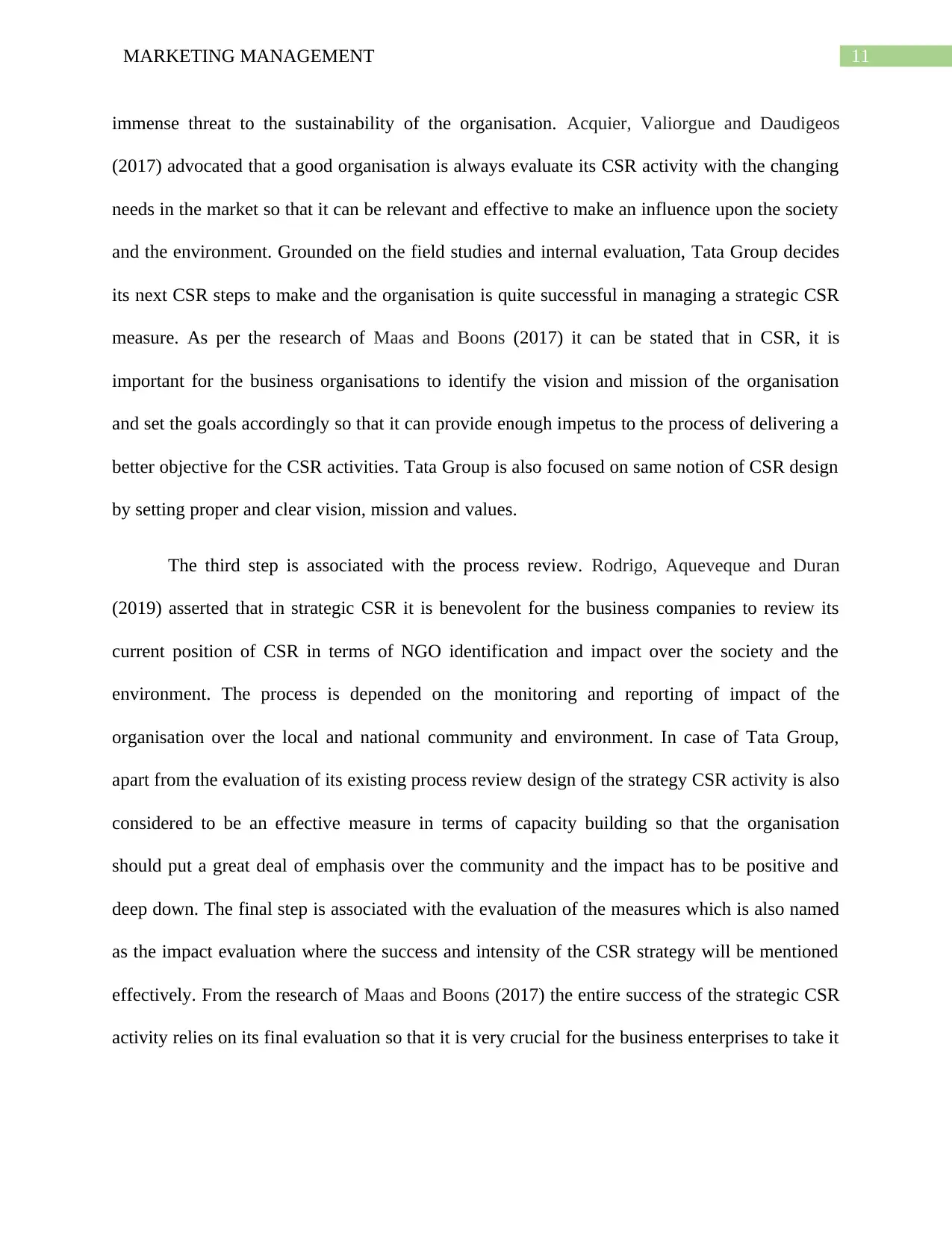
11MARKETING MANAGEMENT
immense threat to the sustainability of the organisation. Acquier, Valiorgue and Daudigeos
(2017) advocated that a good organisation is always evaluate its CSR activity with the changing
needs in the market so that it can be relevant and effective to make an influence upon the society
and the environment. Grounded on the field studies and internal evaluation, Tata Group decides
its next CSR steps to make and the organisation is quite successful in managing a strategic CSR
measure. As per the research of Maas and Boons (2017) it can be stated that in CSR, it is
important for the business organisations to identify the vision and mission of the organisation
and set the goals accordingly so that it can provide enough impetus to the process of delivering a
better objective for the CSR activities. Tata Group is also focused on same notion of CSR design
by setting proper and clear vision, mission and values.
The third step is associated with the process review. Rodrigo, Aqueveque and Duran
(2019) asserted that in strategic CSR it is benevolent for the business companies to review its
current position of CSR in terms of NGO identification and impact over the society and the
environment. The process is depended on the monitoring and reporting of impact of the
organisation over the local and national community and environment. In case of Tata Group,
apart from the evaluation of its existing process review design of the strategy CSR activity is also
considered to be an effective measure in terms of capacity building so that the organisation
should put a great deal of emphasis over the community and the impact has to be positive and
deep down. The final step is associated with the evaluation of the measures which is also named
as the impact evaluation where the success and intensity of the CSR strategy will be mentioned
effectively. From the research of Maas and Boons (2017) the entire success of the strategic CSR
activity relies on its final evaluation so that it is very crucial for the business enterprises to take it
immense threat to the sustainability of the organisation. Acquier, Valiorgue and Daudigeos
(2017) advocated that a good organisation is always evaluate its CSR activity with the changing
needs in the market so that it can be relevant and effective to make an influence upon the society
and the environment. Grounded on the field studies and internal evaluation, Tata Group decides
its next CSR steps to make and the organisation is quite successful in managing a strategic CSR
measure. As per the research of Maas and Boons (2017) it can be stated that in CSR, it is
important for the business organisations to identify the vision and mission of the organisation
and set the goals accordingly so that it can provide enough impetus to the process of delivering a
better objective for the CSR activities. Tata Group is also focused on same notion of CSR design
by setting proper and clear vision, mission and values.
The third step is associated with the process review. Rodrigo, Aqueveque and Duran
(2019) asserted that in strategic CSR it is benevolent for the business companies to review its
current position of CSR in terms of NGO identification and impact over the society and the
environment. The process is depended on the monitoring and reporting of impact of the
organisation over the local and national community and environment. In case of Tata Group,
apart from the evaluation of its existing process review design of the strategy CSR activity is also
considered to be an effective measure in terms of capacity building so that the organisation
should put a great deal of emphasis over the community and the impact has to be positive and
deep down. The final step is associated with the evaluation of the measures which is also named
as the impact evaluation where the success and intensity of the CSR strategy will be mentioned
effectively. From the research of Maas and Boons (2017) the entire success of the strategic CSR
activity relies on its final evaluation so that it is very crucial for the business enterprises to take it
⊘ This is a preview!⊘
Do you want full access?
Subscribe today to unlock all pages.

Trusted by 1+ million students worldwide
1 out of 26
Related Documents
Your All-in-One AI-Powered Toolkit for Academic Success.
+13062052269
info@desklib.com
Available 24*7 on WhatsApp / Email
![[object Object]](/_next/static/media/star-bottom.7253800d.svg)
Unlock your academic potential
Copyright © 2020–2025 A2Z Services. All Rights Reserved. Developed and managed by ZUCOL.





